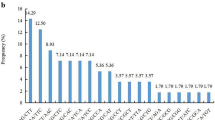Abstract
This study has analyzed the molecular basis and genetic behaviour of the polymorphism generated by the amplification of barley genomic DNA with primers complementary to microsatellites. Primers anchored at the 5′ end, used alone or in combination with arbitrary sequence primers, generated random amplified microsatellite polymorphisms (RAMPs). Unanchored primers were also used as single primers in a microsatellite primed-PCR (MP-PCR). Twenty six randomly selected RAMP DNA fragments which showed polymorphism between the cultivars Steptoe and Morex were cloned and sequenced. All sequences showed the expected repeated motif at the end of the insert, with the number of repeats ranging from five to ten. Genomic sequences containing low numbers of microsatellite motifs were preferentially amplified; therefore, only a fraction of the polymorphism could be attributed to variation in the number of microsatellite motifs at the priming site. Some sequences contained either cryptic simple sequences or members of families of repeated DNA. Polymorphism at the internal cryptic simple sequences was detected by RAMP bands inherited as co-dominant markers. Four MP-PCR bands were cloned and sequenced. A number of repeats identical to the primer itself were found at each end of the insert. Two allelic bands were polymorphic for an internal microsatellite. The potential use of cloned bands as fingerprinting tools was investigated by employing them as hybridization probes in Southern blots containing digested barley DNA from a sample of cultivars. RAMP probes produced complex hybridization band patterns. MP-PCR probes produced either a highly variable single locus or low-copy number loci. Segregations for 31 RAMPs and three MP-PCR bands were studied in a population of 70 doubled-haploids from the Steptoe/Morex cross. One third of all markers were co-dominantly inherited. Markers were positioned on an RFLP map and found to be distributed in all barley chromosomes. The new markers enlarged the overall length of the map to 1408 cM.
Similar content being viewed by others
Author information
Authors and Affiliations
Additional information
Received: 6 May 1998 / Accepted: 20 July 1998
Rights and permissions
About this article
Cite this article
Dávila, J., Loarce, Y. & Ferrer, E. Molecular characterization and genetic map** of random amplified microsatellite polymorphism in barley. Theor Appl Genet 98, 265–273 (1999). https://doi.org/10.1007/s001220051067
Issue Date:
DOI: https://doi.org/10.1007/s001220051067




